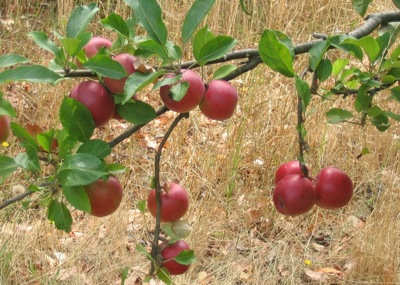This story was produced in collaboration with NPR, with help from producer Cindy Carpien. Sasha’s radio story aired on The California Report on June 8, and will also air later this month as part of NPR’s series on water and the West.

Does climate change spell doomsday for California agriculture?
That’s what Nobel-prize winning physicist Steven Chu told the Los Angeles Times in an interview, soon after President Obama appointed him Secretary of Energy.
“I don’t think the American public has gripped in its gut what could happen,” he told the Times in February. “We’re looking at a scenario where there’s no more agriculture in California.”
For another perspective, I called UC Davis ag economist Richard Howitt, who focuses on water and California agriculture, to ask him what he thought.
“That’s a highly inaccurate statement,” Howitt said. “Steven got carried away. Brilliant man, but he doesn’t know anything about California water.”
Howitt’s models show climate change will likely lead to a 25% reduction in the state’s water supply over the next 50 years. He says that will likely mean some rough times ahead for farmers, but certainly not the end of California’s role as an agricultural powerhouse.
In fact, Howitt says if California farmers can continue to grow more drought-tolerant crops and cut back on flood irrigation, they’re likely to thrive in the marketplace over the long term:
“As income increases, people eat more California fruit, nuts, and vegetables,” he says. “They don’t care about cotton; they don’t care about corn. We are on the right side of the agricultural business in terms of future growth.”
Of course, that means if you were to fly over the Central Valley in 50 years, you’d probably see fewer emerald-green islands of crops like rice, alfalfa, and cotton–and more fields of wheat and flexible crops like canning tomatoes, which can be planted seasonally and according to demand.
“This will, of course mean that we have less slack in the system than we do now,” says Howitt. “We’re going to have to be much better at applying water, look a little more like Israel and a little less like Northern California.”
Engineers who specialize in irrigation technology have long looked to drought-stricken countries for models. The folks who developed the Pure Sense software I discuss in my radio story have collaborated extensively with farmers in Australia.
Howitt also says no matter how efficiently farmers apply water, they have to figure out how to more efficiently move it around the state. Rather than just fighting over smelt, salmon, and pumping in the Sacramento-San Joaquin Delta, Howitt thinks farmers could be more efficient if we plumb water east to west (currently the two major water systems in California are primarily north-south oriented). Howitt says that would create incentives for farmers in relatively water-rich areas, like the east side of the San Joaquin Valley, to sell water to farms with good soil but less water–like the west side of the San Joaquin Valley, home to the some of the largest and wealthiest farms in the world.
Tricking plants into yielding more with less
Meanwhile, the idea of “dry farming,” like what the folks at Sonoma County’s Flatland Farm are doing with their apples, is getting popular in coastal areas. Dry-farmed tomatoes, like these from Santa Cruz, are increasingly popular at farmer’s markets.
Some researchers are taking this concept to places where it doesn’t rain so much. The idea is to control irrigation to stress the plants to the point where they think they’re starting to die, which triggers the plant’s genetic imperative to produce more fruit. David Goldhamer, who advises Central Valley farmers through the UC Cooperative extension, has demonstrated that farmers who cut back on watering of navel oranges and pistachios, may actually produce higher-quality fruit and generate more income.
A sprinkling of history
I also visited David Zoldoske, at the Center for Irrigation Technology at Fresno State. They have an amazing collection of historical sprinkler systems and a virtual irrigation museum online. Zoldoske has been studying irrigation and water efficiency for decades. Here’s what he told me about how agriculture is going to have to adapt to warming temperatures:
“I think the thing to remember here is there is no silver bullet. There is no reservoir or canal or any other technology or engineering feat that’s going to solve this problem. We’re going to have to use every tool in the toolbox. It’s going to take multiple feats of engineering elegance so we can solve this problem. And it’s still possible that we’ll fail. And I don’t want to be saying that we will fail. We need to be very focused on this. It’s going to be a long journey. We won’t solve it over night.”
Learn more:
Ag and Climate Change
The entire April-June issue of the University of California’s quarterly journal, California Agriculture, is devoted to research on climate change and how it may fundamentally alter California’s environment and landscape, agriculture and food quality.
Saving Every Drop:
The California Institute for Rural Studies has profiled some of the most efficient California farmers in their January report, California Water Stewards: Innovative On-Farm management Practices (.pdf link).
The institute is also tied into the California Agricultural Water Stewardship Initiative (CAWSI), which has just launched a new website that features farmers using less water.
4 thoughts on “Ag and Water: Making Do with Less”
Comments are closed.

Hey, they are using drip-irrigation even in India to produce record crops in states like Tamil Nadu. Its called precision farming. Check it out.
Some usefull links
http://www.hindu.com/2009/07/02/stories/2009070258990300.htm
http://www.hindu.com/2009/03/04/stories/2009030451380300.htm
http://www.thehindu.com/2009/05/30/stories/2009053058650300.htm
http://www.thehindu.com/2009/06/11/stories/2009061151070300.htm